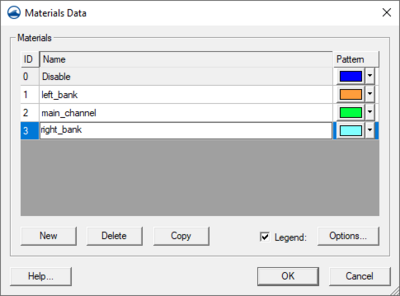SMS:Materials Data: Difference between revisions
No edit summary |
|||
| Line 3: | Line 3: | ||
== Dialog Description == | == Dialog Description == | ||
The ''Materials Data'' dialog is accessible from the menu command [[SMS:SMS Menus#Edit Menu|Edit | Materials]] or from model specific ''material properties'' windows (ex. [[SMS:ADH Material Properties|ADH]]), available in the model specific menu. The dialog is resizable by dragging on the window edges. | The ''Materials Data'' dialog is accessible from the menu command [[SMS:SMS Menus#Edit Menu|''Edit'' | '''Materials''']] or from model specific ''material properties'' windows (ex. [[SMS:ADH Material Properties|ADH]]), available in the model specific menu. The dialog is resizable by dragging on the window edges. | ||
When a new mesh element or grid cell is created, the material is assigned to the new object based on the materials options in the [[SMS:Mesh Element Options|Element Options | When a new mesh element or grid cell is created, the material is assigned to the new object based on the materials options in the [[SMS:Mesh Element Options|''Element Options'']] dialog. | ||
Model specific material properties such as Manning's n and Eddy viscosity are edited using commands available in the model specific menu. | Model specific material properties such as Manning's n and Eddy viscosity are edited using commands available in the model specific menu. | ||
Revision as of 18:44, 24 April 2013
Many of the data entities constructed and edited in SMS (i.e., elements, cells) have a material ID associated with them. This material ID is an index into a list of material types. Materials contain model specific parameters such as manning's roughness, or bed material grain size. A global list of material attributes is maintained and can be edited using the menu command Edit | Materials. This command brings up the Materials Data dialog where each material is assigned an ID number. This dialog can be used to delete unused materials, create new materials, and assign a descriptive name, color, and pattern to a material. This general information is saved in the material file. The materials defined within the Materials Data dialog are available for all modules.
Dialog Description
The Materials Data dialog is accessible from the menu command Edit | Materials or from model specific material properties windows (ex. ADH), available in the model specific menu. The dialog is resizable by dragging on the window edges.
When a new mesh element or grid cell is created, the material is assigned to the new object based on the materials options in the Element Options dialog.
Model specific material properties such as Manning's n and Eddy viscosity are edited using commands available in the model specific menu.
Materials Spreadsheet
The materials spreadsheet contains three columns (ID, Name, and Pattern) for the defined materials. All IDs must be unique and the spreadsheet can be sorted by clicking on the column headings. The default "Disable" material cannot be edited (except the display pattern) and will always be at the top of the spreadsheet regardless of sorting. Each material is accompanied by a pattern button in the Pattern column. To select a pattern, click on the preview section (left side) of the button to open the Pattern Attributes window. To quickly edit only the color, click on the down arrow (right side) of the button, and make a selection in the pop up color palette.
Buttons
- New – Inserts a material into the spreadsheet with the lowest unique ID available and a default name and pattern.
- Delete – Removes the currently selected material from the spreadsheet.
- Copy – Creates and inserts a copy of the currently selected material with the lowest unique ID available and a default "copy of" name.
Legend
- Legend – Check box with the associated Options... button controls the display of a legend of the materials in the Graphics Window.
- Options... – Opens the Legend Options dialog. The options for the legend are edited in the Legend Options dialog. These options include:
- The name to be displayed on the legend.
- The specification of where on the screen the legend will appear.
- The font to be used in the legend.
- The size of each entry in the legend.
Note: only active materials are included in the legend.
Related Topics
SMS – Surface-water Modeling System | ||
|---|---|---|
| Modules: | 1D Grid • Cartesian Grid • Curvilinear Grid • GIS • Map • Mesh • Particle • Quadtree • Raster • Scatter • UGrid |  |
| General Models: | 3D Structure • FVCOM • Generic • PTM | |
| Coastal Models: | ADCIRC • BOUSS-2D • CGWAVE • CMS-Flow • CMS-Wave • GenCade • STWAVE • WAM | |
| Riverine/Estuarine Models: | AdH • HEC-RAS • HYDRO AS-2D • RMA2 • RMA4 • SRH-2D • TUFLOW • TUFLOW FV | |
| Aquaveo • SMS Tutorials • SMS Workflows | ||
